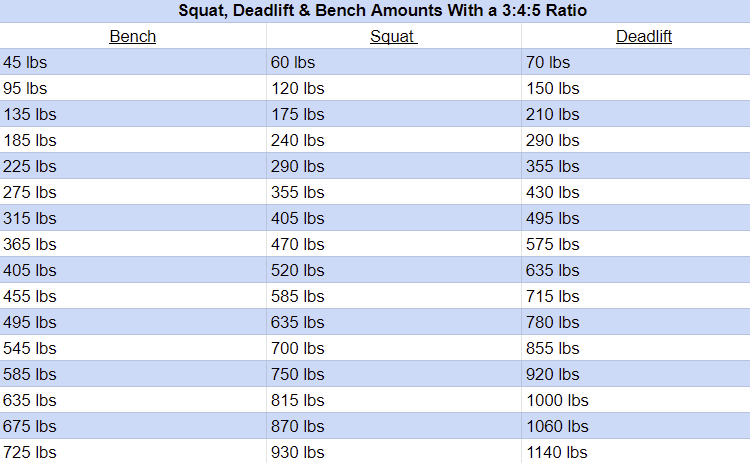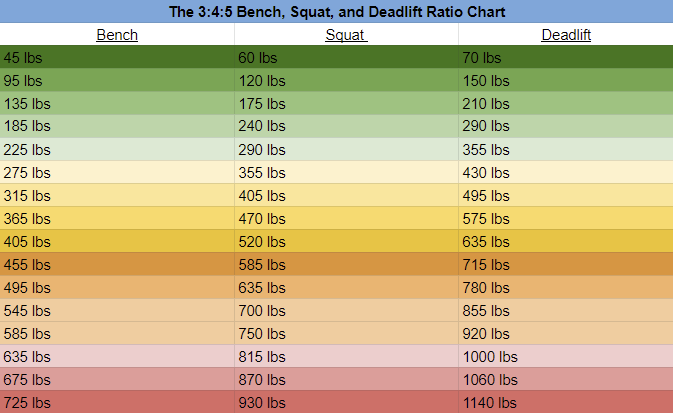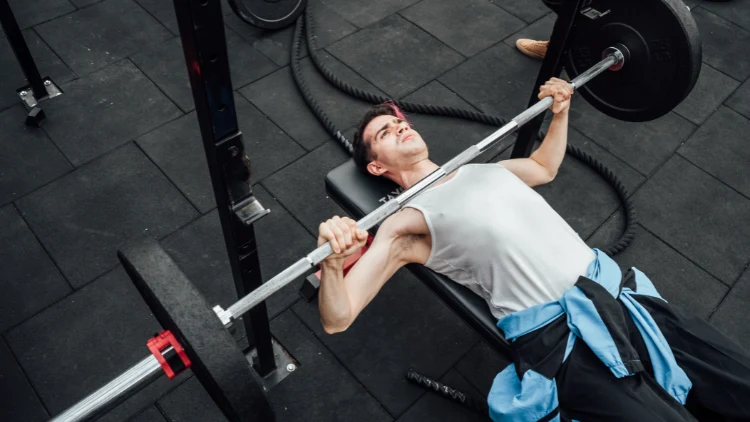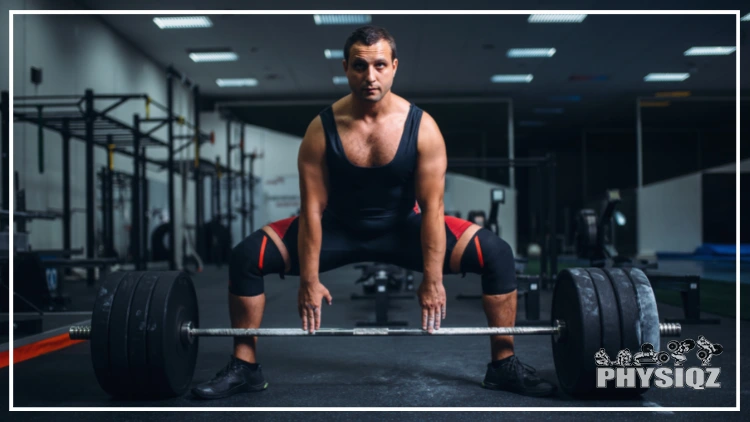
The bench squat deadlift ratio helps serious gymgoers and powerlifters see if their big 3 lifts are somewhat equal, if one of their lifts are lagging behind, and if their lifts are good, impressive or average when compared to others.
And to their defense, it’s not all ego because having an ideal ratio in mind can go a long way to setting informed and realistic goals.
Most strive for a squat, deadlift, bench ratio of 3:4:5 which is close to a desired goal of 315 bench, 405 squat, and a 495 deadlift. But these exact amounts and the ratio doesn’t account for differences in weight, fitness levels, experience training, or bodily proportions.
To get a better idea if this was accurate or not, we conducted a study and compiled data on powerlifting weight classes and their average lifts which showed that the same ratio is largely true for even the most elite powerlifters, and across several different weight classes.
With this compilation of data, it’s possible to see how much of deadlift you should squat and we’ll also provide tables of various strength standards for bench, squats and deadlifts of the general population.
Note, powerlifters may want to look at the powerlifting average lifts above for a better gauge on powerlifting strength standards.
What Is the Bench Squat Deadlift Ratio?
The squat-bench-deadlift ratio is the concept of an ideal ratio of pounds lifted in each lift that someone should work towards or try to maintain. In theory, someone who trains each of the three lifts effectively should improve at somewhat predictable rates.
A reliable, single ratio would let lifters know that their training is coming along well, while also letting them know when one of their lifts is progressing more slowly than it should. In most cases, trained men will deadlift moderately more than they can squat and squat much more than they bench press.1
However, ideal ratios change from person to person because of the impact that a person’s physical characteristics have on their performance of each lift.2
What’s an Ideal Bench Squat Deadlift Ratio?
The most common example of a ratio between the big three is 3:4:5 for bench:squat:deadlift. It’s easy to remember and it’s close to the classic long-term goals of a 315 bench, 405 squat, and a 495 deadlift.
Another way to put this is:
- Your bench press should correlate with the strength standards below, or if you’re a powerlifter, then with the strength standards of your class.
- Your squat should be 128.57142857142858% of your bench
- Your deadlift should be 122.22222222222223% of your squat
However, this is only one example of an ideal ratio and it won’t be ideal for everyone.
It accurately reflects a level of strength that someone might expect to reach after several years of quality training, but it’s not very applicable to people at more or less advanced stages of their training.
Even if someone meets all the strength standards and trains perfectly, their ratio won’t be 3:4:5 for a long time. This is because the bench press, back squat, and deadlift start out at similar levels for a novice and then grow at different rates.
In most cases, the bench press and deadlift will grow at relatively consistent speeds, but a person’s deadlift weight grows much faster. The biggest variable is the squat; it grows slower than the deadlift earlier in someone’s lifting career, but can eventually catch up to or even overtake the deadlift.
A beginner is doing well if their bench, squat, and deadlift ratio is 3 : 3.7 : 4.5. As an example, that’s roughly 150 bench, 185 squat and 225 deadlift which reflects realistic strength goals but is lower than 3:4:5.
On the other hand, highly experienced or elite athletes will often deadlift more than the 3:4:5 ratio implies, and they’ll squat much more.
The 3:4:5 Bench, Squat, & Deadlift Ratio Chart
We took the liberty to take the %s above and place them into an easy to read chart. Note, each number has been rounded + or – to the nearest interval of 5 because most gyms only have 2.5 weight plates.

Bench Squat Deadlift Ratio Strength Standards
While a 3:4:5 is commonly seen, there’s no single bench squat deadlift ratio or standard because ideal performance at each lift changes at different rates. While bench press standards are usually consistent, a person will post greater deadlift gains early in their training and greater squat gains later.
Plus, men of different sizes will have different realistic optimal performances. This means that standards and ratios for these three lifts are dynamic depending on a person’s weight class and experience as a lifter.
Here are the standards for each lift, an explanation of the tier system, and the ratio that’s normal at each tier:
- New Lifter: Someone in their first month or so of resistance training, with little muscle development or form. A new lifter’s ratio will typically be around 1:1:1 because they lack the supporting muscles and technique to perform the squat and deadlift as well as they could.
- Beginner: Around three to six months of consistent training will put someone at the beginner level. Bench will increase by 25-35%, squat should grow by 50-80% depending on body size, and deadlift should nearly double. At this stage, a 1:1.25:1.5 ratio (or 3 : 3.75 : 4.5, approximately 150/185/225) is realistic and represents great progress.
- Intermediate: Someone is an intermediate lifter at the range of six months to two years of training. At this point, the squat-to-bench and deadlift-to-bench ratios should continue to grow but remain short of 3:4:5.
- Experienced: An experienced lifter has employed advanced techniques and trained for two to five years to surpass the intermediate tier. There’s considerable variance based on body type and size, but ratios of 3:4:5 will be approximate for many lifters in this tier.
- Expert: Lifters who have been training consistently for five years or more and have competitive-level strength are in the expert tier. At this level, squat performance grows relatively faster than other lifts and so 3 : 4.5 : 5 (300 bench/450 squat/500 deadlift). is typical. Among lifters of certain body types, it’s common for squats and deadlifts to reverse positions in the ratio, so that squat weight is higher than the deadlift.
There are a few key takeaways from these trends. While there are standards and ideal strength ratios, these ratios are different over time and for different body types.
The bench press is the most consistent lift over time, with similar proportionate gains for larger and smaller men. On the other hand, the squat is the most inconsistent lift, as body type and weight play an especially large role in the squat.
Instead of following preset standards, learn the genetics that are affecting your squat form and set personalized expectations for best results. If a person has shorter limbs and a very small or very large build, their squat will be closer to their deadlift than most people’s.
Bench Press Standards for Men
Note, these are average bench press standards for men and most people don’t lift. However, if you start to look at the intermediate to expert levels a rough ratio of 3:4:5 can be seen.
Body Weight (116 lbs)
- New Lifter: 90 lbs
- Beginner: 115 lbs
- Intermediate: 135 lbs
- Experienced: 185 lbs
- Expert: 225 lbs
Body Weight (123 lbs)
- New Lifter: 95 lbs
- Beginner: 125 lbs
- Intermediate: 145 lbs
- Experienced: 200 lbs
- Expert: 245 lbs
Body Weight (131 lbs)
- New Lifter: 105 lbs
- Beginner: 135 lbs
- Intermediate: 160 lbs
- Experienced: 220 lbs
- Expert: 265 lbs
Body Weight (147 lbs)
- New Lifter: 115 lbs
- Beginner: 150 lbs
- Intermediate: 175 lbs
- Experienced: 240 lbs
- Expert: 295 lbs
Body Weight (164 lbs)
- New Lifter: 125 lbs
- Beginner: 160 lbs
- Intermediate: 190 lbs
- Experienced: 260 lbs
- Expert: 325 lbs
Body Weight (179 lbs)
- New Lifter: 135 lbs
- Beginner: 170 lbs
- Intermediate: 210 lbs
- Experienced: 280 lbs
- Expert: 350 lbs
Body Weight (199 lbs)
- New Lifter: 140 lbs
- Beginner: 180 lbs
- Intermediate: 220 lbs
- Experienced: 295 lbs
- Expert: 365 lbs
Body Weight (219 lbs)
- New Lifter: 145 lbs
- Beginner: 190 lbs
- Intermediate: 230 lbs
- Experienced: 310 lbs
- Expert: 385 lbs
Body Weight (241 lbs)
- New Lifter: 150 lbs
- Beginner: 195 lbs
- Intermediate: 240 lbs
- Experienced: 320 lbs
- Expert: 400 lbs
Body Weight (280 lbs)
- New Lifter: 155 lbs
- Beginner: 200 lbs
- Intermediate: 250 lbs
- Experienced: 330 lbs
- Expert: 410 lbs
Body Weight (320 lbs)
- New Lifter: 160 lbs
- Beginner: 205 lbs
- Intermediate: 255 lbs
- Experienced: 340 lbs
- Expert: 420lbs
Body Weight (320+ lbs)
- New Lifter: 165 lbs
- Beginner: 210 lbs
- Intermediate: 260 lbs
- Experienced: 345 lbs
- Expert: 430 lbs
Squat Standards for Men
The same lies true for squats. Beginners bench, squat, and deadlift ratio will not be an accurate representation of a 3:4:5, but it’s good information to have for those just starting and wondering if 405 squat is good for male standards.
Body Weight (115 lbs)
- New Lifter: 80 lbs
- Beginner: 145 lbs
- Intermediate: 175 lbs
- Experienced: 240 lbs
- Expert: 320 lbs
Body Weight (124 lbs)
- New Lifter: 85 lbs
- Beginner: 155 lbs
- Intermediate: 190 lbs
- Experienced: 260 lbs
- Expert: 345 lbs
Body Weight (133 lbs)
- New Lifter: 90 lbs
- Beginner: 170 lbs
- Intermediate: 205 lbs
- Experienced: 280 lbs
- Expert: 370 lbs
Body Weight (149 lbs)
- New Lifter: 100 lbs
- Beginner: 190 lbs
- Intermediate: 230 lbs
- Experienced: 315 lbs
- Expert: 410 lbs
Body Weight (166 lbs)
- New Lifter: 110 lbs
- Beginner: 205 lbs
- Intermediate: 250 lbs
- Experienced: 340 lbs
- Expert: 445 lbs
Body Weight (180 lbs)
- New Lifter: 120 lbs
- Beginner: 220 lbs
- Intermediate: 270 lbs
- Experienced: 370 lbs
- Expert: 480 lbs
Body Weight (199 lbs)
- New Lifter: 125 lbs
- Beginner: 230 lbs
- Intermediate: 285 lbs
- Experienced: 390 lbs
- Expert: 505 lbs
Body Weight (220 lbs)
- New Lifter: 130 lbs
- Beginner: 245 lbs
- Intermediate: 300 lbs
- Experienced: 410 lbs
- Expert: 530 lbs
Body Weight (242 lbs)
- New Lifter: 135 lbs
- Beginner: 255 lbs
- Intermediate: 310 lbs
- Experienced: 425 lbs
- Expert: 550 lbs
Body Weight (275 lbs)
- New Lifter: 140 lbs
- Beginner: 260 lbs
- Intermediate: 320 lbs
- Experienced: 435 lbs
- Expert: 570 lbs
Body Weight (319 lbs)
- New Lifter: 145 lbs
- Beginner: 270 lbs
- Intermediate: 325 lbs
- Experienced: 445 lbs
- Expert: 580 lbs
Body Weight (320+ lbs)
- New Lifter: 150 lbs
- Beginner: 275 lbs
- Intermediate: 330 lbs
- Experienced: 455 lbs
- Expert: 595 lbs
Deadlift Standards for Men
Lastly, deadlifts are the heaviest lift of them all yet the ratio can still be roughly seen here in the more experienced levels.
Body Weight (114 lbs)
- New Lifter: 95 lbs
- Beginner: 180 lbs
- Intermediate: 205 lbs
- Experienced: 300 lbs
- Expert: 385 lbs
Body Weight (123 lbs)
- New Lifter: 105 lbs
- Beginner: 195 lbs
- Intermediate: 220 lbs
- Experienced: 320 lbs
- Expert: 415 lbs
Body Weight (132 lbs)
- New Lifter: 115 lbs
- Beginner: 210 lbs
- Intermediate: 240 lbs
- Experienced: 340 lbs
- Expert: 440 lbs
Body Weight (148 lbs)
- New Lifter: 125 lbs
- Beginner: 235 lbs
- Intermediate: 270 lbs
- Experienced: 380 lbs
- Expert: 480 lbs
Body Weight (165 lbs)
- New Lifter: 135 lbs
- Beginner: 255 lbs
- Intermediate: 295 lbs
- Experienced: 410 lbs
- Expert: 520 lbs
Body Weight (181 lbs)
- New Lifter: 150 lbs
- Beginner: 275 lbs
- Intermediate: 315 lbs
- Experienced: 440 lbs
- Expert: 550 lbs
Body Weight (198 lbs)
- New Lifter: 155 lbs
- Beginner: 290 lbs
- Intermediate: 335 lbs
- Experienced: 460 lbs
- Expert: 565 lbs
Body Weight (220 lbs)
- New Lifter: 165 lbs
- Beginner: 305 lbs
- Intermediate: 350 lbs
- Experienced: 480 lbs
- Expert: 585 lbs
Body Weight (242 lbs)
- New Lifter: 170 lbs
- Beginner: 320 lbs
- Intermediate: 365 lbs
- Experienced: 490 lbs
- Expert: 595 lbs
Body Weight (275 lbs)
- New Lifter: 175 lbs
- Beginner: 325 lbs
- Intermediate: 375 lbs
- Experienced: 500 lbs
- Expert: 600 lbs
Body Weight (319 lbs)
- New Lifter: 180 lbs
- Beginner: 335 lbs
- Intermediate: 380 lbs
- Experienced: 505 lbs
- Expert: 610 lbs
Body Weight (320+ lbs)
- New Lifter: 185 lbs
- Beginner: 340 lbs
- Intermediate: 390 lbs
- Experienced: 510 lbs
- Expert: 615 lbs
What’s an Ideal Ratio of Bench Press to Squat?
The odd relationship that squats have with body weight and experience make it difficult to suggest a single ratio for them. However, a person’s squat should be considerably higher than their bench press unless they’re a brand new lifter.
Anywhere between 3 : 3.7 and 3:5 is a reasonable ratio that may indicate a person is training both lifts well.
Is It Normal or Okay To Bench More Than You Squat?
There are two cases where it would be more or less fine for a person to bench more than squat. On the one hand, those who are just starting out should expect to have a low squat weight for some time.
With zero training on either the bench press or the squat, it’s normal to bench press more weight.
However, most people who are interested in fitness won’t really have zero experience at bench press-style movements. A push-up and other pushing exercises provide similar training to the bench press, and these bodyweight exercises transfer to the bench press better than bodyweight squats transfer to free-weight back squats.3

Source: Mike Gonzalez via Canva.com4
A free weight squat demands much greater grip strength as well as specific, hard-to-develop core strength. Someone who’s been training with push-ups might be a strong beginner in terms of bench press strength while still being a novice with the back squat.
It could take between three months and a year of training the squat to even out this difference if that is the case.
The second case is that many people only train the bench press and aren’t interested in squatting due to preferences or injuries. Naturally, they aren’t going to do great when squatting and will probably have a higher bench press.
While such people are missing out on the quality of life-sustaining core strength and hormonal benefits that squats offer, it’s okay as a personal decision.
When someone is actively trying to improve their squat but their bench press remains higher, it indicates an abnormality in their training progress.
There are a few potential reasons for this lack of progress.
Reasons Why You Squat Less Than You Bench
Proficiency: Form is key in all exercises, and good squat form is more complex than good bench form. It’s a very technical motion, and proficiency alone can make a huge difference in the amount of weight someone can handle.
A squat-heavy program like the Bulgarian squat method can help a person build this proficiency and increase their squat by 25-50 lbs in just a month.
Psychology: The squat is one of the most intimidating exercises out there. Sports hernias from squats are just one risk of bad form, and losing control of the bar can also result in injury.
With these kinds of risks in the back of a lifter’s mind, it’s not hard to imagine that someone might hesitate to increase the weight or end a set prematurely. If a person isn’t at ease under the bar, they’re not going to perform at their best and see the gains they want.
Genetics and Lack of Mobility: Proportions and other physical characteristics can have a major impact on lift performance and ideal form. For instance, someone with a longer femur (thigh bone) than their tibia (shin bone) will have to have more forward lean to their squat while someone with a shorter femur will have to be more upright.
A person might also have particularly short arms or a deeper arch when benching, both of which would help push their bench press higher relative to the squat. Another possibility is that someone could have poor ankle mobility, which would hinder their squat form and reduce performance.
If a person suspects they have mobility issues with the squat, they should consult a sports physical therapist to evaluate their movement patterns and make recommendations.
Increasing Squat Performance
When someone is underperforming on the squat, the first step is to go back to basics. If it’s difficult to control the weight and complete the motion with perfect form, then set pride aside and reduce the weight as much as necessary.
Prioritize form and volume with modest weight as a means of practicing the movement more than pushing the muscles. This will help build the mind-muscle connection, even if it doesn’t generate as much hypertrophy as more intense programs.
From there, set a short-term goal of performing sets of 12 reps with perfect form, increase the weight, and repeat. A few months of moderate intensity, progressive overload workout program is a great way to build a foundation of skill and core strength to successfully perform this challenging lift.
Only ratchet up the weight to maximize gains with high-intensity workouts after developing this baseline level of proficiency.5
What’s a Good Balance Between Bench Press & Deadlift?
While a new lifter might bench and deadlift similar weights, that changes dramatically once someone has been training for a few months. While the traditional ratio is 3:5, most people are going to be closer to 3 : 4.5 for the first few years of lifting.
That said, someone who’s just started will often have a deadlift that’s much less than 150% of their bench. Their deadlift might even be less than their bench.
While the deadlift isn’t as technical as the squat, it still has its quirks and is more complex than the bench press. If a person just isn’t seeing progress from their deadlift workout, then the plan is essentially the same as with the squat.
Going back to basics and focusing on proper form and grip technique while performing long sets of moderate intensity will help them get a grip on the exercise. After building foundational strength with a few months of volume-oriented training, they can shift to short sets at high weight to maximize hypertrophy and strength gains.

Source: nomadsoulphotos via Canva.com6
If they can do that, their deadlift will start to grow and they should be deadlifting at least 25% more than they bench before long. Keep at it, and the deadlift will start to reflect that ideal ratio of 3 : 4.5-5.
What’s a Healthy Deadlift to Squat Ratio?
Comparing the deadlift to the squat is the hardest comparison to make within the ratio of bench, squat, and deadlift because it changes so much over time. The average person will be making good progress on both lifts if they can squat 80%-90% of the deadlift.
However, it’s not at all unheard of for some people to squat more than their deadlift. This doesn’t always mean that a person is deadlifting less than they should be, though.
Medium-sized people are, relatively speaking, the best at the deadlift. Experienced lifters between 160 and 200 lbs will find that the 3:4:5 guideline is more accurate for them than others.
However, very light and very heavy men often squat more compared to their deadlift than men of moderate weight. This trend bears out in data from the 2015 IPF World Powerlifting Championships:7
| Weight Class at 2015 IPF World Powerlifting Championships | Squat Performance Relative to Deadlift |
| 130 lbs | 4.5:5 (90%) |
| 145 lbs | 4.4:5 (88%) |
| 163 lbs | 4.3:5 (86%) |
| 183 lbs | 4.3:5 (86%) |
| 205 lbs | 4.4:5 (88%) |
| 231 lbs | 4.6:5 (92%) |
| 264 lbs | 4.9:5 (98%) |
| 264+ lbs | 5.2:5 (104%) |
This points to the fact that calculating the optimal ratio between squatting and deadlift requires taking two contradictory facts into account. On the one hand, a squat moves more of a person’s body weight than the deadlift, so weighing very little is an advantage for the squat.
On the other hand, very large people have greater strength overall, and the squat is able to utilize this more than the deadlift. Eventually, the advantage of extra strength outweighs the disadvantage of greater body weight and it becomes possible for a person to squat as much as they deadlift.
This is especially true of lifters with shorter limbs relative to their body size, which is typical among the sort of elite powerlifters who compete at world championships.
At the end of the day, the most important thing is for a person to track their own progress and set their own goals. The classic 3:4:5 goals of a 315 bench, 405 squat, and 495 deadlift are great long-term targets, but short-term goals usually won’t reflect this ratio.
They should be more personalized and take body size, body shape, and experience into account. Either that, or rely on the 3:4:5 ratio as a rough guideline while understanding when and why it might not apply.
Having ratios is helpful for providing long-term goals, but using them as short-term guidelines requires more adjustment and personalization. The ideal bench squat deadlift ratio changes from person to person as well as over time, especially for their squat and deadlift, but 3:4:5 works well as a long-term goal.
References
1Nigro, F. (2020, July). A Comparison Between the Squat and the Deadlift for Lower Body Strength and Power Training. NCBI. Accessed December 30th, 2022, from <https://www.ncbi.nlm.nih.gov/pmc/articles/PMC7386153/>
2Ferland, P.-M. (2020, May). The Relationship Between Physical Characteristics and Maximal Strength in Men Practicing the Back Squat, the Bench Press and the Deadlift. NCBI. Accessed December 30th, 2022, from <https://www.ncbi.nlm.nih.gov/pmc/articles/PMC7386153/>
3Alizadeh, S. (2020, May). Push-Ups vs. Bench Press Differences in Repetitions and Muscle Activation Between Sexes. NCBI. Accessed December 30th, 2022, from <https://www.ncbi.nlm.nih.gov/pmc/articles/PMC7196742/>
4Gonzalez, Mike. Canva. Accessed 19 April 2023. <https://www.canva.com/photos/MAFT8FEueZY-a-man-doing-bench-press/>
5Mangine, G. T. (2015, August). The effect of training volume and intensity on improvements in muscular strength and size in resistance-trained men. NCBI. Accessed December 30th, 2022, from <https://www.ncbi.nlm.nih.gov/pmc/articles/PMC4562558/>
6nomadsoulphotos. Canva. Accessed 19 April 2023. <https://www.canva.com/photos/MADsWu1TEBM-male-powerlifter-starting-deadlift-barbell-in-gym/>
7International Powerlifting Federation. (2015, June). Classic World Men’s Championships, Salo (Finland), 05-14.06.2015. IPF International Powerlifting. Accessed December 30th, 2022, from <https://www.powerlifting.sport/fileadmin/ipf/data/results/2015/Classic-Powerlifting/mens/detailed_scoresheet.htm>